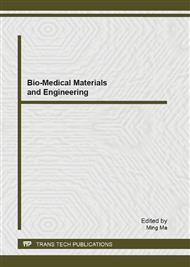[1]
C. Yao, B. Jiang, T. Li, B. Qin, X. Feng and S. Tu: Bioorg. & Med. Chem. Lett Vol. 21 (2011), pp.599-601.
Google Scholar
[2]
K. Pasunooti, H. Chai, C. Jensen, B. Gorityala, S. Wang and X. Liu: Tetra. Lett Vol. 52 (2011), pp.80-84.
Google Scholar
[3]
X. Wu, R. Jiang, X. Xu, X, Su, W. Lu and S. Ji: J. of Comb. Chem Vol. 12 (2011), pp.829-835.
Google Scholar
[4]
L. Geng, G. Feng and J. Yu: J. of Chem. Res Vol. 10 (2010), pp.565-567.
Google Scholar
[5]
M. Adib, S. Ansari, S. Fatemi, H. Bijanzadeh and L.G. Zhu: Tetrahedron Vol. 66 (2010), pp.2723-2727.
DOI: 10.1016/j.tet.2010.01.108
Google Scholar
[6]
S.L. Wang, C. Cheng, F.Y. Wu, B. Jiang, F. Shi, S.J. Tu, T. Rajale and G. Li: Tetrahedron Vol. 67 (2011), pp.4485-4493.
Google Scholar
[7]
F. Shi, J. Ding, S. Zhang, W. Hao, C. Cheng and S. Tu: Bioorg. & Med. Chem. Lett Vol. 21 (2011), pp.1554-1558.
Google Scholar
[8]
L. Ma and T. Inokuchi: Chem. Comm Vol. 46 (2010), pp.7037-7039.
Google Scholar
[9]
S. Tu, X. Zhang, Z. Han, X. Cao, S. Wu, S. Yan and N. Ma: J. of Comb. Chem Vol. 11 (2009), pp.428-432.
Google Scholar
[10]
S. Tu, X. Cao, W. Hao, X. Zhang, S. Yan and F. Shi: Org. & Bioorg. Chem Vol. 7 (2009), pp.557-563.
Google Scholar
[11]
A. Loupy, in: Microwave in organic synthesis, 2nd ed, edtied by Wiley-VCH, Weinheim, Germany(2006).
Google Scholar
[12]
P. Lidstrom, J. Tierney, B. Wathey and J. Westman: Tetrahedron Vol. 57 (2001), pp.9225-9283.
DOI: 10.1016/s0040-4020(01)00906-1
Google Scholar
[13]
L.H. Heitman, T. Mulder-Krieger, R.F. Spanjersberg, J.K. von Frijtag Drabbe Künzel, A. Dalpiaz and A.P. Ijzerman: Brit. J. Pharmacol Vol. 147 (2006), p.533–541.
DOI: 10.1038/sj.bjp.0706655
Google Scholar
[14]
J. Deng, T. Sanchez, L.Q. Al-Mawsawi, R. Dayam, R.A. Yunes, A. Garofalo, M.B. Bolger, and N. Neamati: Bioorg. Med. Chem Vol. 15 (2007), p.4985–5002.
DOI: 10.1016/j.bmc.2007.04.041
Google Scholar
[15]
M.T. Cocco, C. Congiu, V. Lilliu and V. Onnis: Bioorg. Med. Chem Vol. 15 (2007), p.1859–1867.
Google Scholar
[16]
T. Reddy, R. Mutter, W. Heal, K. Guo, V. Gillet, S. Pratt and B. Chen: J. of Med. Chem Vol. 49 (2006), pp.607-615.
Google Scholar
[17]
K. Guo, R. Mutter, W. Heal, T. Reddy, H. Cope, S. Pratt, M. Thompson and B. Chen: Eur. J. of Med. Chem Vol. 43 (2008), pp.93-106.
Google Scholar
[18]
S. Kambe, K. Saito, A. Sakurai and H. Midorikawa: Synthesis Vol. 7 (1981), p.531–533.
Google Scholar
[19]
A.H.H. Elghandour, M.K.A. Ibrahim, F.M.M. Ali and S.M.M. Elshikh: Indian J. Chem., Sect. B: Org. Chem. Incl. Med. Chem Vol. 36 (1997), p.79–82.
Google Scholar
[20]
K. Guo, M.J. Thompson, T.K.R. Reddy, R. Mutter and B. Chen: Tetrahedron Vol. 63 (2007), p.5300–5311.
Google Scholar
[21]
K. Guo, M.J. Thompson and B. Chen: J. Org. Chem Vol. 74 (2009), pp.6999-7006.
Google Scholar
[22]
Two sets of reactions were carried out, inclusion and exclusion of air. In the first set, degassed solvents were employed. Reactions were performed with nitrogen protection. Therefore, results represented the contribution from Knoevenagel adduct. In the second set, reactions were carried out inclusion of air. Therefore, results showed contribution of both Knoevenagel adduct and aerobic oxidation. Aerobic oxidation was calculated by reducing the first set from the second set.
DOI: 10.1017/cbo9780511697692.023
Google Scholar


